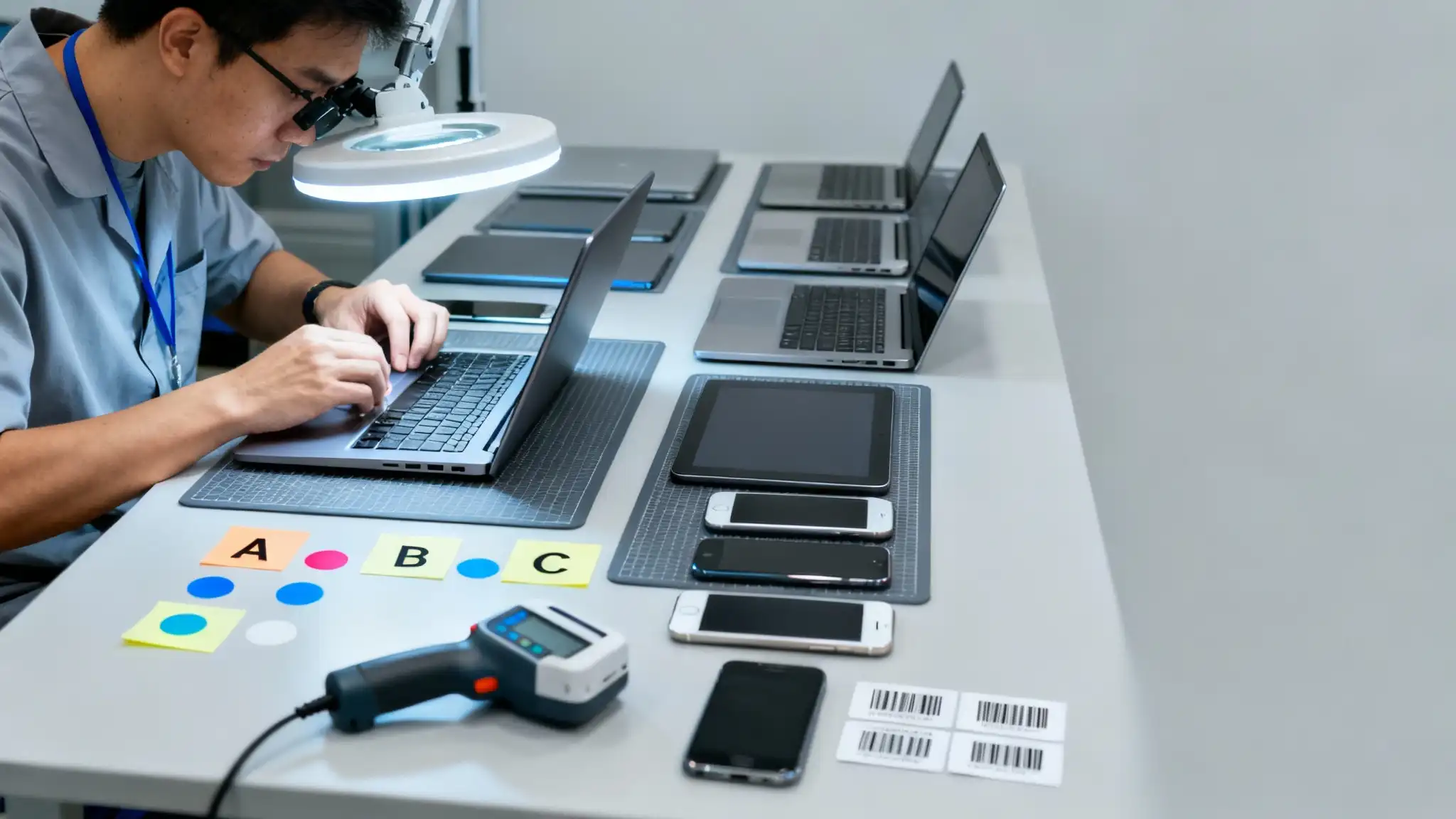Purpose: Provide a clear, audit-ready standard operating procedure (SOP) for refurbishing IT assets, assigning consistent cosmetic and functional grades, verifying data sanitization, and authorizing units for resale or redeployment.
Applies to: Laptops, desktops, all-in-ones, servers, monitors, mobile devices, and small peripherals in an ITAD/e-waste recycling context aligned with R2v3 and common enterprise expectations.
1) Roles and responsibilities
- Refurb Lead: Owns this SOP, updates test matrices, approves deviations.
- Technician: Executes functional testing, cleaning, minor repairs, grading, and labeling.
- Data Technician: Performs data wipe and verification; isolates failures.
- Quality Assurance (QA): Performs sample audits, signs final release, monitors KPIs.
- Warehouse Coordinator: Maintains chain-of-custody, locations, and pick-ready staging.
2) Pre-requisites and workspace standards
- ESD controls: Wrist straps, grounded mats, humidity and temperature within equipment specs.
- Clean bench: Dust control, compressed air, microfiber cloths, approved cleaning agents only.
- Tools: Diagnostic USBs, stress-test utilities, battery health tools, pixel checkers, screw kits, thermal paste, barcode labeler.
- Parts stock: RAM, SSDs/HDDs, power bricks, CMOS batteries, fans, hinges, cables.
- Safety: PPE for cleaning chemicals; lockout/tagout for high-voltage monitors; fire-rated containers for suspect batteries.
- Records: Asset ID labels tied to a device record (make, model, serial, customer lot, intake date, and data classification if provided).
3) Process overview (high level)
- Intake & Triage: Verify asset ID, external condition, power-on eligibility, data classification, and customer instructions.
- Data Sanitization: Wipe or destroy per policy. Verify and log results.
- Functional Testing: Apply model-specific test matrix. Record pass/fail and repairs performed.
- Cosmetic Grading: Assign grade using the rubrics below; capture supporting photos.
- Final QC Gate: QA sample-checks function, cosmetics, labeling, and documentation.
- Release to Sale: Generate spec label and listing attributes; move to pick-ready location.
4) Data sanitization & verification (must be completed before functional testing that accesses user data)
Isolation: Devices with storage media are quarantined in a limited-access area until wiped or storage removed.
Method selection: Based on storage type and customer policy (e.g., overwrite for HDD, cryptographic erase or overwrite for SSD; physical destruction when required).
Execution:
- Confirm the asset ID and media serial match the record.
- Apply the approved sanitization method with verification enabled.
- For multi-drive systems (RAID, dual storage), sanitize each device individually.
Verification: - Save a report (or log) with asset ID, storage serial(s), method, date/time, technician ID, and result (success/fail).
- Random sample audit: QA re-runs verification on at least 5% of wiped units per lot.
Failures: - If wipe fails or verification is incomplete, reattempt once. If still failing, escalate to physical destruction or specialized handling per policy.
Recordkeeping: - Attach the wipe report to the device record.
- Apply a “Data Cleared” label with date, technician initials, and method.
5) Functional testing matrices
Create model-agnostic matrices with minimum pass levels and optional enhancements. Below is a baseline you can adapt.
5.1 Laptops
- Power & POST: Boots without error beeps; BIOS accessible; correct CPU and RAM detected.
- Battery health: Reported design vs. full charge capacity; Grade A ≥ 80%, B 60–79%, C < 60% (or include new battery).
- Keyboard & input: All keys register; trackpad click and movement consistent.
- Display: No cracks; brightness uniform; no pressure marks; pixel test (allowable defects per grading rubric).
- Storage & RAM: SMART check; surface scan or short DST; memory test pass.
- Ports & wireless: USB, video out, audio, Wi-Fi, Bluetooth verified.
- Thermals: 15-minute stress test; fans functional; temps within spec.
- Camera & speakers: Basic mic and speaker test; camera detection.
- Cosmetic: Apply grading rubric (below); hinge stiffness acceptable.
5.2 Desktops/All-in-Ones/Servers
- POST stability: No hardware errors; time/date set; RAID healthy.
- Storage: SMART/DST pass; SSD life check; confirm bays populated as listed.
- Thermals & noise: 20-minute stress test; no abnormal bearing noise.
- I/O: USB, NIC(s), display outputs, audio; add-on cards recognized.
- Power supply: Voltage rails within tolerance under load (software or hardware tester).
- Cosmetic: Chassis straight, no deep bends; bezels intact; grills unobstructed.
5.3 Monitors
- Panel: No cracks; brightness uniformity acceptable; color shift within tolerance; pixel defect count per grade.
- OSD & ports: Buttons work; HDMI/DP tested; stand adjustments functional.
- Backlight hours: If available, record to inform grade/price.
- Power supply: Internal or external brick verified.
5.4 Mobile devices (phones/tablets)
- Activation lock: Confirm off.
- Screen & touch: Multi-touch test; glass integrity; no image retention.
- Battery health: Report percentage if available; fast charge check.
- Buttons & sensors: Power/volume, cameras, mic, speakers, vibration, proximity sensor, Wi-Fi, Bluetooth, cellular.
- Storage health: Basic read/write test; no i/o errors.
Documentation: Every test step records Pass/Fail, technician initials, date, and notes on repairs (parts used, times).
6) Cosmetic grading rubric (A/B/C/D)
Use consistent, objective criteria and require photos for B- and C-grade units. If in doubt, grade down.
Grade A (Excellent)
- Housings: No dents or cracks. Hairline scratches only; < 3 light marks not visible beyond 30 cm.
- Displays: No cracks, chips, bright spots, pressure marks, or deep scratches. Pixels: 0 bright; ≤ 2 dark subpixels allowed if not clustered.
- Keyboards/trackpads: Minimal wear; legends fully visible; no shine on > 10% of keys.
- Batteries: Laptops ≥ 80% design capacity; mobiles ≥ vendor “good” threshold.
- Monitors: Stand fully functional; no discolorations; backlight uniform.
Grade B (Good)
- Housings: Minor scuffs/scratches visible at 30 cm; 1 small ding (< 3 mm) acceptable; no cracks affecting structure.
- Displays: Up to 1 minor pressure mark or hairline scratch not visible on white screen at 30 cm; Pixels: ≤ 3 total defects; no clusters.
- Keyboards/trackpads: Moderate cosmetic wear; all legends legible; function normal.
- Batteries: Laptops 60–79% design capacity.
- Monitors: Minor bezel wear; ≤ 2 small dust spots not visible in normal use.
Grade C (Fair/Functional)
- Housings: Noticeable wear, multiple scuffs, or up to 2 small dings; no sharp edges or exposed internals.
- Displays: Noticeable scratch or pressure mark visible in bright screens but not obstructing primary content; Pixels: ≤ 5 defects; minor image retention allowed.
- Keyboards/trackpads: Heavy wear but functional; replacement caps allowed if consistent.
- Batteries: < 60% capacity or holding charge but below B threshold.
- Monitors: Noticeable wear; limited uniformity issues; stand may have 1 function missing if VESA mount provided.
Grade D (Parts/Repair)
- Cracks, missing plastics, dead pixels in clusters, severe pressure marks, faulty ports, failed thermal tests, activation lock present, or battery unsafe. Not for resale until repaired and re-graded; else route to parts or recycling per policy.
Photo evidence:
- 3 angles minimum (front, back, side/hinge).
- Close-ups for any B/C-defining blemishes with a scale reference (coin or ruler).
- Save filenames with Asset ID and grade.
7) Repairs and replacements
- Approved repairs: RAM/SSD upgrades, keyboard/trackpad swaps, fan/heatsink service, screen replacements, hinges, rubber feet, CMOS batteries, power bricks.
- Non-approved repairs: Board-level rework unless by certified tech in ESD area; cosmetic filling/painting that may hide damage; unsafe battery manipulation.
- Parts traceability: Record part number, condition (new/pulled/refurb), supplier, and technician.
- Re-test: After any repair, repeat affected functional tests before grading.
8) Labeling & documentation
Each asset must carry:
- Front label: Make/Model, CPU, RAM, Storage, Screen size/resolution, GPU (if any), Wi-Fi, OS license indicator (if applicable), Battery health (laptops/mobiles), Grade, and Asset ID (barcode).
- Media label: “Data Cleared” with method, date, initials; or “No Storage.”
- Box label (if kitted): Asset ID(s), quantity, grade mix, gross weight, pick location.
Device record must include: Intake details, customer lot, serial(s), wipe report, functional test results, repairs, cosmetic grade with photos, QA result, and final disposition.
9) Final QA gate and release to sale
Sampling: QA reviews at least 10% of ready units per lot (increase to 100% for new technicians or high defect rates).
Checks:
- Data wipe documentation present and matches asset.
- Functional test sheet complete; spot-check critical items (display, storage health, ports).
- Cosmetic grade matches photos and rubric; no misrepresented defects.
- Labels accurate; barcode scannable; accessories correct (power adapters, stands).
Disposition: - Pass: QA signs off; asset is moved to “Pick-Ready.”
- Fail: Return to technician with reason. Log corrective action. Re-audit fails weekly to identify trends.
10) KPIs and quality thresholds
- First-pass yield (FPY): Target ≥ 92% for tested units.
- Return rate (DOA within 30 days): Target ≤ 2%.
- Grading accuracy (QA disagreements): ≤ 3% variance between Tech and QA.
- Sanitization compliance: 100% with verifiable logs; 0 critical deviations.
- Cycle time: Intake to pick-ready median hours by asset class; set realistic goals and publish weekly.
- Battery upgrade attach rate: Percentage of laptops below B threshold upgraded before sale (track margin impact).
11) Common pitfalls and how to prevent them
- Inconsistent battery health readings: Standardize on one tool and one methodology (full charge, health query, cooldown). Add the reading to labels.
- Pixel defect disputes: Enforce the numeric thresholds per grade; always include photo evidence with a pixel-test background.
- Hidden defects in hinges/stands: Add a mandatory “open/close 10x” step for laptops and “tilt/height pivot” for monitors.
- Thermal throttling missed: Require a short stress test with temperature logging for every CPU-based device.
- Sanitization log mismatches: Barcode-scan asset and drive serials into the wipe tool; avoid manual entry when possible.
- Accessories mismatch: Kitting checklist at boxing; weigh boxes to flag missing bricks or stands.
12) Records and retention
Maintain the following for the retention period in your compliance program:
- Device records (intake → disposition) including wipe reports, test results, photos, labels, and QA sign-off.
- Repair parts traceability logs.
- Nonconformity and corrective action logs.
- KPI dashboards and weekly QA sampling sheets.
- Technician training and authorization matrix.
13) Release-to-sale checklist (technician + QA sign-off)
- Data sanitization: method, report, and label present.
- Functional tests: all required steps passed; re-test after repairs done.
- Cosmetic grade assigned per rubric; photos captured for B/C.
- Battery health captured on label (if applicable).
- Labels: spec + barcode + grade + asset ID; box label if kitted.
- Accessories matched; power output verified.
- QA sample audit completed and signed.
- Inventory location updated to “Pick-Ready.”
14) Continuous improvement
- Review KPIs weekly; if FPY drops or QA disagreements rise, retrain on the most-missed steps.
- Update the grading photo gallery with examples so new techs calibrate faster.
- Refresh test matrices quarterly to reflect new common models, firmware changes, and failure patterns.
- Invite feedback from sales and returns teams to tune grading thresholds and descriptions.
Summary
This SOP gives technicians and auditors the same thing they want: repeatable processes, objective grades, and verifiable records. By sequencing sanitization → testing → cosmetic grading → QA → release, and documenting each step with reports, photos, and labels, you reduce nonconformities, returns, and disputes—while speeding time to sale and protecting data at every stage.


Leave a Reply